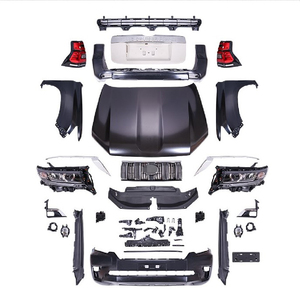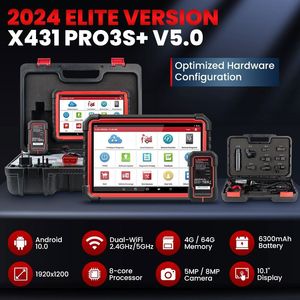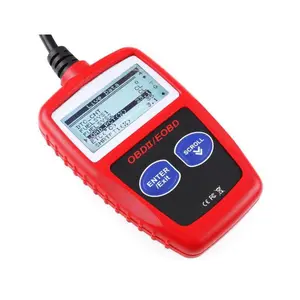Types of Car Scanners
A car scanner is a vital tool for diagnosing and understanding a vehicle's health status. With technology advancement, several types of car scanners are available to suit various needs and budgets.
Handheld OBD-II Scanners
These are portable and easy-to-use car scanners that connect to the vehicle's OBD-II port to read and clear diagnostic trouble codes (DTCs).
- Small screen displays essential information
- Widely used by mechanics and car owners
- Affordable price point
- Perfect for basic diagnostics
Best for: Everyday car owners and beginner mechanics
Bluetooth OBD-II Adapters
These devices plug into the OBD-II port of a car and communicate wirelessly with a smartphone or tablet for real-time diagnostics.
- Works with specialized mobile apps
- Ideal for tech-savvy users
- More affordable than advanced scanners
- Provides convenient mobility during diagnostics
Best for: Tech-oriented users who prefer using their mobile devices
Professional-Grade Scanners
With the ability to perform in-depth diagnostics across multiple systems, these scanners are designed for automotive professionals.
- Access engine, transmission, ABS, and other modules
- Run active tests and perform programming
- Extensive features including live data streaming
- Higher price point for advanced functionality
Best for: Professional mechanics and auto repair shops
Specifically designed for vehicles constructed in Europe, such as Audi, BMW, Mercedes, and Volkswagen. These scanners comply with the strict standards and protocols of Euro vehicles, ensuring accurate diagnostics and compatibility.
These specialized scanners can program new keys, read key information, and perform key-related functions. They are vital tools for locksmiths and automotive key professionals for key duplication, ignition repairs, and key-related services.
Developed for particular car systems or components, such as ABS, airbags, or engines. For example, an ABS scanner focuses on the anti-lock brake system's diagnostic functions, essential for deep diagnostics and troubleshooting complex issues.
| Scanner Type | Best For | Price Range | Key Features |
|---|---|---|---|
| Handheld OBD-II | DIY enthusiasts, basic diagnostics | $30-$150 | Code reading/clearing, portable design |
| Bluetooth Adapters | Smartphone users, casual diagnostics | $15-$100 | Wireless connectivity, app integration |
| Professional Scanners | Professional mechanics, repair shops | $200-$5,000+ | Advanced diagnostics, programming capabilities |
| European Car Scanners | European vehicle specialists | $100-$3,000 | Special protocols for European vehicles |
| Key Programmers | Locksmiths, key services | $150-$2,000 | Key coding, immobilizer programming |
Expert Tip: When selecting a scanner type, consider not only your current needs but also potential future requirements. A slightly more advanced scanner might save you from purchasing a new one as your diagnostic needs evolve.
Specifications and Maintenance of Car Scanners
Key Specifications
Car scanners get power from different sources:
- OBD port powered (most common)
- Internal battery (for portability)
- USB connection to computer
- AC adapter for workshop use
The method by which scanners communicate with vehicle systems:
- Wireless (Bluetooth/Wi-Fi) for mobility
- Wired (USB/Serial) for stability
- Transfer speed affects diagnostic time
- Signal strength impacts reliability
Screen characteristics affect usability:
- Size (from 2" to 10"+)
- Resolution and color capability
- Touchscreen vs. button navigation
- Outdoor visibility considerations
Range of diagnostic capabilities:
- Basic: read/clear codes only
- Intermediate: live data, freeze frame
- Advanced: bidirectional controls, programming
- Specialized: manufacturer-specific functions
Vehicle coverage spectrum:
- Universal OBD-II (1996+ vehicles)
- Make-specific (Ford, Toyota, etc.)
- Region-specific (US, European, Asian)
- Protocol support (CAN, ISO, SAE, etc.)
Maintenance Best Practices
| Maintenance Task | Frequency | Importance | Notes |
|---|---|---|---|
| Software Updates | Every 3-6 months | Critical | Ensures compatibility with newer vehicles and access to latest diagnostic capabilities |
| Physical Cleaning | After each use | Moderate | Use soft cloth for screen, connector pins require special attention |
| Battery Maintenance | Monthly | High | For battery-powered units, follow charging recommendations to extend lifespan |
| Cable Inspection | Monthly | High | Check for fraying, bent pins, or damage that could affect connectivity |
| Storage Procedure | After each use | Moderate | Store in carrying case away from extreme temperatures and humidity |
Important: Never disconnect a scanner while it's communicating with a vehicle's computer. This can potentially damage both the scanner and the vehicle's electronic control modules.
Maintenance Tip: Create a schedule for scanner updates and maintenance tasks. Many professional shops set monthly reminders to ensure their diagnostic equipment stays current and reliable.
How to Choose a Car Scanner
Selecting the right car scanner requires careful consideration of several critical factors to ensure it meets your specific needs and provides reliable service.
For DIY Enthusiasts
Focus on these priorities:
- User-friendly interface
- Clear explanations of error codes
- Reasonable price point ($30-$150)
- Basic diagnostics for common issues
- Compatibility with your specific vehicle
For Professional Mechanics
Look for these advanced features:
- Multi-system diagnostics
- Bidirectional controls
- Programming capabilities
- Wide vehicle compatibility
- Regular software updates
- Technical support availability
Selection Criteria Checklist
Opt for well-known manufacturers with proven track records for reliable products and consistent customer support. Quality brands typically offer better update policies and more accurate diagnostics.
Verify the scanner works with your specific vehicle makes and models. Some scanners are universal while others are designed for specific brands or regions (US, European, Asian).
Consider the range of functions you need: basic code reading, live data streaming, actuation testing, or advanced programming. More features typically mean higher cost.
Evaluate how often you'll transport the scanner and whether size matters for your workspace. Handheld units offer convenience while larger units may provide better displays.
Consider whether you need a scanner powered by the OBD port, internal battery, or external power. Battery-powered units offer more flexibility but require charging.
Determine if real-time sensor data monitoring is necessary for your diagnostic needs. This feature is valuable for identifying intermittent issues.
Check the manufacturer's update policy—free lifetime updates provide better long-term value than subscription-based models. Regular updates ensure compatibility with newer vehicles.
Assess screen size, resolution, and user interface. A touchscreen with intuitive navigation can significantly improve the diagnostic experience.
Verify warranty terms and availability of technical support. A good warranty protects your investment, while responsive support helps resolve issues quickly.
Establish a realistic budget based on your needs. While professional-grade scanners can cost thousands, many quality options are available in more affordable ranges.
Shopping Tip: Before making a purchase, read user reviews specifically from people who own the same make and model of vehicle you intend to diagnose. Their experiences will provide valuable insights into compatibility and performance with your specific car.
How to DIY and Replace Car Scanner
Whether upgrading to a more advanced model or replacing a malfunctioning scanner, follow these step-by-step instructions for a smooth transition.
Identify the Type of Code
Compare the code-reading capabilities of your old and new scanners to ensure compatibility:
- Verify both scanners support the same OBD protocols
- Check manufacturer-specific code compatibility
- Ensure the new scanner can access the same vehicle systems
Backup Data
Preserve important information from your old scanner:
- Export any saved diagnostic reports
- Record custom settings and parameters
- Save vehicle profiles if applicable
- Document any personalized configurations
Connect the New Scanner
Properly set up your new diagnostic tool:
- Locate the OBD-II port (typically under the dashboard near the steering wheel)
- Ensure the ignition is in the appropriate position per manufacturer instructions
- Connect the scanner firmly to establish a secure connection
- Follow any initialization procedures in the manual
Transfer Settings
Configure your new scanner with previous settings:
- If available, use manufacturer software to transfer profiles
- Manually recreate important custom configurations
- Update language preferences and measurement units
- Set up vehicle profiles for frequently diagnosed cars
Test It Out
Verify proper function of the new scanner:
- Run a full system scan on your vehicle
- Compare results with your previous scanner (if possible)
- Test all required functions and features
- Ensure it communicates with all necessary vehicle systems
Dispose of the Old Scanner
Responsibly handle your old equipment:
- Check local electronics recycling regulations
- Remove any personal data or vehicle information
- Consider selling functional units to recoup costs
- Use manufacturer take-back programs if available
Familiarize with the New Scanner
Take time to learn your new diagnostic tool:
- Read the manual thoroughly
- Watch manufacturer tutorial videos if available
- Start with basic functions before attempting advanced features
- Join user forums for tips and troubleshooting help
Warning: Never attempt to use a scanner that has visible damage to cables or connectors. This could potentially harm your vehicle's electronic systems or create inaccurate diagnostic results.
Frequently Asked Questions
A car scanner is an automotive diagnostic tool used to interact with a vehicle's control systems. It connects to the onboard computer to retrieve information, including error codes, real-time data, and vehicle specifications. Modern scanners range from simple code readers to sophisticated diagnostic computers that can access multiple vehicle systems and perform programming functions.
A car scanner works by establishing a communication link with a vehicle's onboard diagnostic system through the OBD (On-Board Diagnostic) port. Once connected, it can:
- Query the vehicle's ECU (Engine Control Unit) and other control modules
- Read and interpret diagnostic trouble codes (DTCs)
- Access real-time sensor data and performance parameters
- Perform active testing of components and systems
- In advanced models, reprogram control modules and perform system calibrations
A car scanner is an essential tool for several important reasons:
- Accurate Diagnostics: Helps pinpoint exact issues without guesswork
- Time and Cost Savings: Reduces diagnostic time and prevents unnecessary parts replacement
- Preventive Maintenance: Identifies potential problems before they become serious
- Performance Monitoring: Allows tracking of engine efficiency and system performance
- DIY Capability: Empowers vehicle owners to understand and address simple issues
- Safety: Ensures critical vehicle systems like brakes and airbags are functioning properly
Car scanners have varying levels of compatibility depending on their design and capabilities:
- Basic OBD-II scanners work on most vehicles manufactured after 1996 (US), 2001 (EU gasoline), and 2004 (EU diesel)
- Not all scanners can access all vehicle systems - many basic models only read engine codes
- Manufacturer-specific functions often require specialized scanners or adapters
- Vehicles built before OBD-II standardization may require brand-specific diagnostic tools
- Some newer electric and hybrid vehicles may have proprietary systems requiring specialized diagnostic equipment
Always check compatibility before purchasing a scanner for specific vehicle makes and models.
The ability to perform vehicle software updates varies significantly based on the scanner's capabilities:
- Basic scanners: Cannot perform any software updates
- Mid-range scanners: May update specific modules in some vehicle models
- Professional scanners: Often can perform software updates on compatible vehicles
- Dealer-level tools: Have the most comprehensive update capabilities
Important considerations regarding scanner software updates:
- Many manufacturers restrict access to software updates to authorized dealerships
- Updates often require specific authorization credentials or licenses
- Failed or interrupted updates can potentially damage vehicle modules
- For critical systems, manufacturer-approved tools are strongly recommended






























































































































































































































































 浙公网安备 33010002000092号
浙公网安备 33010002000092号 浙B2-20120091-4
浙B2-20120091-4